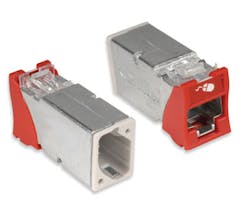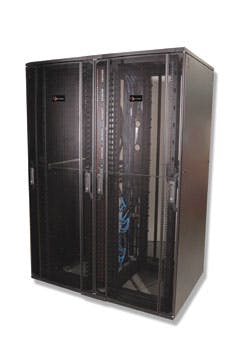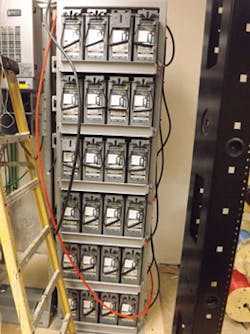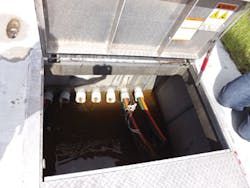Advanced cabling solutions enhance emergency operations
From the November 2012 Issue of Cabling Installation & Maintenance Magazine
The Lee County, Florida Emergency Operations Center's network is "shielded from disaster" as it monitors severe weather and other disturbances.
By Robert Carlson, The Siemon Company
Statistically impacted by hurricanes every two-and-a-half years with average winds of 112 mph, Southwest Florida certainly has experienced its share of natural disasters. The existing Lee County Emergency Operations Center (EOC) in Fort Myers, originally built in the 1970s as a nuclear fallout shelter, has served the community well, especially during the 2004 and 2005 hurricane seasons that experienced significant damage from Hurricane Charley and Hurricane Wilma, respectively. But Lee County has outgrown its EOC. Its lack of space, outdated technology and inability to withstand a Category 5 storm surge has made a new larger, advanced facility an absolute necessity.
Soon to serve as the county's nerve center of emergency operations, the new 27,000-square-foot facility has been a long time in the making. Built with thick reinforced concrete, the new EOC sits 32 feet above sea level and is designed to resist winds over 200 mph-stronger than the most intense hurricane. "The new EOC will be able to withstand anything Mother Nature or man can bestow on our community and still function as an emergency operations center," says John Wilson, Lee County's director of public safety. The new facility is also rated for a seven-day survivability factor with all the backup systems needed to operate for a week freestanding.
Quickly approaching a fall 2012 completion at the time of this writing, and due to be in service for the 2013 hurricane season, the new EOC features the very latest networking, communications and media applications needed to make critical decisions, effectively coordinate resources and deliver information and services to Lee County residents faster in the event of an emergency. At the heart of the EOC is an advanced data center and shielded cabling infrastructure that will ensure effective, ongoing current and future operations to serve the county for many years to come.
Building bigger and better
As the official warning point for Lee County, the EOC is responsible for monitoring severe weather and tropical disturbances, providing support and assistance for first responders and mobile response units, developing emergency response plans and shelter standards, collecting and distributing emergency information, and conducting hazardous-materials analysis, drills and briefings. The county also uses social media to update residents and even offers a free downloadable "Lee Evac" app to help residents identify evacuation zones.
During an emergency, the EOC is in full activation and staffed with key personnel from various agencies, relief organizations, utility companies and other essential county departments to act as the focal point for coordinating an emergency response and recovery. Effectively monitoring and delivering critical information for the county requires an advanced network infrastructure with bandwidth to quickly transfer information, reliability to ensure uptime and capacity to support a wide variety of equipment and applications.
While the county has an existing outside plant (OSP) singlemode fiber backbone in place for connecting a multitude of county facilities, the network infrastructure at the previous EOC didn't stack up. It lacked the bandwidth to transfer up-to-date digital images of an unfolding emergency, requiring 30 minutes to print out maps that were then tacked to the wall. The previous EOC's lack of network capacity and equipment also had 150 people sharing phones and using their own laptops during an emergency. Masses of cables for network equipment lay unprotected because they couldn't be placed on concrete walls. There was no space for permanently storing critical information-requiring data to be stored in three separate off-site data centers. During an emergency, officials had to physically carry backup disks to be stored at the EOC.
"Decades ago, when technology was still in its infancy, the existing EOC was adequate," says Dalton Moraes, manager of network operations for Lee County. "One thing we learned from the events of 9/11 was not to put all our eggs in one basket. It was a big wake-up call that took us by surprise. We learned that relying on a single technology such as push-to-talk mobile devices could not handle all of the communications that need to happen during a major emergency."
The audio-visual (A/V) capabilities of the network were also ineffective and inefficient. A microphone had to be held up to a phone to make a conference call in the existing situation room, and respondents had to go to the microphone to speak. The new EOC will solve all these issues for the county.
"The new EOC will consolidate the county's existing three separate data centers into one data center that is essentially designed as a bunker with concrete on all sides," explains David D. Southwick III, RCDD, senior project manager with TLC Engineering for Architecture (www.tlc-engineers.com), the firm responsible for designing the new EOC network infrastructure. "Due to the critical nature of the operations, the county also wanted to ensure complete redundancy for reliability."
Redundant singlemode fiber feeds come into the new EOC's data center from both the north and the south. Some of the fiber terminates to a dense wavelength division multiplexing (DWDM) switch that has the capability to transmit 10 Gbits/sec on up to 40 channels, for a total potential of 400 Gbits/sec worth of bandwidth. Within the data center, core switches, servers and a storage area network (SAN) provide all of the services for the entire county. Connected to the data center is a separate main telecommunications room that houses all of the switches necessary to support EOC operations.
Stephen Mason, telecommunications/transport project manager with Lee County, further explains: "The data center at the EOC is for county-wide functions. It supports all of the other facilities throughout the county. Within the EOC building itself, all of the spaces tie back to the separate main telecommunications room, which has the ability to operate completely independently of the data center if necessary."
Within the main telecommunications room for the EOC, Power over Ethernet (PoE) switches provide links for all of the computers, phones, speakers, cameras and other devices throughout the EOC. The main telecommunications room also connects to other telecommunications spaces throughout the facility, including a media room, A/V room, radio room and life-safety equipment room.
"The main telecommunications room is situated in a way that allows everything within the EOC to tie back through this space to the data center," explains Moraes. "We have conduit and methods in place for bringing the outside fiber directly into the main telecommunications room if for some reason we needed to move the data center and have the EOC function on its own."
A 4,200-square-foot situation room with flat-screen monitors at the new EOC is more than twice the size of the old situation room, providing emergency staff with more elbow room and network connections to avoid anyone having to share phones and computers. It features two breakout rooms with full A/V connections that allows individual groups to meet quietly on conference calls or with other groups for specific functions.
"The situation room is where everyone gathers during an emergency to make key decisions and coordinate resources," says Moraes. "When it's not hurricane season, we will use this space for training, events and other meetings. The two breakout rooms at the back of the situation rom can be converted into smaller isolated rooms. Depending on the level of activation in an emergency, these rooms provide separate private spaces for other groups like FEMA, the FBI or Homeland Security to come in and set up their own operations as needed."
A new, larger media room that can be isolated from the situation room will provide advanced, real-time transmission capabilities for the media. The room is being named after Booch de Marchi, a public servant who was the face of Lee County for more than 20 years. Booch passed away from cancer in 2011, and his ashes are buried at the new EOC.
Pinpointing a performance partner
To select the right cabling and connectivity components for the new EOC network infrastructure, Lee County worked with the design engineer to provide a detailed specification and review several bids from various local installation companies. "We carefully reviewed all of the bids to ensure that the county needs were met," says Southwick. "The bids were eventually narrowed down to two different vendors and two different installation companies, each of whom met with the county and provided the technical information we needed."
With thorough support, technical guidance and detailed product information provided by Jaime Gallego, regional sales manager for The Siemon Company, the county ultimately selected Siemon cable, connectivity, cabinets and cable management for the EOC. The county partnered with Fort Myers-based Fiber Solutions (www.fiber-solutions.com) to provide the installation and certification of the infrastructure.
"This is one of the most important projects that has happened in our area over the past few years," says Joseph Baublis III, RCDD, senior engineer with Fiber Solutions. "We knew that working with Siemon was our best bet-and that and our long-term relationship with Lee County was our one-two punch for winning the bid."
"When it comes to selecting vendors and installers, we had to not only look at the performance of the products, but the overall experience, number of past projects, warranty and long-term support," says Mason. "Siemon and Fiber Solutions were able to provide us with high-performance end-to-end cabling systems and a 20-year warranty. They also were willing to work closely with us and our local Anixter distributor to make sure we met the needs of the project from both a price and inventory standpoint."
In addition to providing products, Siemon certified several Lee County information technology personnel as Siemon Certified Installers (CIs) through its certified installer program that includes training courses based on the latest cabling industry standards. "By certifying county staff as Siemon CIs, the technicians have a better understanding of what they are working with and they are certified to do their own moves, adds and changes," explains Southwick.
Outfitting the nerve center
The data center at the EOC that will serve the county includes five rows of eight cabinets for a total of 40 cabinets. Twenty-four of the cabinets will house all of the equipment that will eventually be moved from other facilities to the EOC. The remaining cabinets will support the county's transport equipment and provide room for growth and expansion, allowing county agencies to implement backup networks as needed.
Within the data center, all of the fiber connections between core switches and equipment are achieved with Siemon's Plug and Play system. This system features trunk cables that consist of Siemon's RazorCore 50-micron laser-optimized multimode fiber cable, factory-terminated to 12-fiber MTP connectors. MTP trunks are connected to Siemon Plug and Play modules that break out two 12-fiber MTP connections at the rear of the module to 24 duplex LC connections at the front of the module. These trunk cables run in redundant, separate pathways between the core switches and the equipment. Each cabinet also includes redundant power to ensure maximum reliability and uptime.
"The use of preterminated solutions helps us avoid loose cables for a better organized and manageable data center," says Moraes. "It also gives us the flexibility to make moves, adds and changes without having to invest in the time and fiber equipment required for field terminations."
In addition to supporting high-density connections and easy installation, the Plug and Play system positions the Lee County EOC to easily shift to 40-Gbit/sec or 100-Gbit/sec links between switches and equipment in the future. Per the IEEE 802.3ba specifications for 40 Gigabit Ethernet, 40-Gbit/sec applications use parallel-optic technology that requires four fibers each transmitting at 10-Gbit/sec and four fibers each receiving at 10-Gbit/sec via multifiber push-on (MPO) connectors like the MTP. Similarly, 100-Gbit/sec Ethernet is expected to use four transmitting and four receiving fibers of 25 Gbits/sec each.
The main telecommunications room that supports EOC operations includes eight cabinets and two racks for housing all the switches needed to serve the EOC. To house the equipment, the Lee County EOC implemented Siemon's VersaPOD cabinets rather than standard 19-inch server cabinets. The VersaPOD enables a completely new and efficient "zero-U" approach to the physical data center infrastructure. By leveraging the vertical space between bayed cabinets for patching and cable management, it frees critical horizontal space for active equipment, while improving airflow by keeping the cabling away from equipment air intakes and/or exhaust areas. Through improved airflow and cooling efficiency, the VersaPOD helps maximize thermal management and energy efficiency.
"We are huge fans of the VersaPOD, and were actually one of the first to install them when the product was released," says Baublis with Fiber Solutions. "It provides a great deal of capacity to manage the patching environment, while providing a neat, aesthetically pleasing solution with plenty of room to grow."
The VersaPOD features dual-hinged, lockable wardrobe doors to limit access to the county's critical emergency network equipment. It features an array of zero-U integrated cable management options that moves cables and patch cords out of the equipment mounting space and into high-capacity vertical cabling zones to support high-density connectivity without compromising manageability or room for growth.
Considering critical communications
From the main telecommunications room, more than 200,000 feet of horizontal cabling connects to more than 1,000 network connections to support phones, computers, high-definition video displays, wireless access points, security cameras and a variety of other networked devices located throughout the EOC. For the horizontal cable, Lee County decided to deploy Siemon's Z-Max 6A Category 6A foiled twisted-pair (F/UTP) copper system.
"The original specification for the project called for Category 6 unshielded cable, but codes and requirements changed over time," explains Southwick. "Once we realized we needed to shift to shielded cabling per the most recent code governing emergency operations, it also made sense to select the latest Category 6A cabling-the county wanted to make sure that they were getting their return on investment and implementing a network that would last and provide plenty of headroom and capacity for future applications. Siemon's shielded cabling system has an established track record."
The 2008 National Electrical Code (NEC), adopted in Lee County after the initial design of the project, includes a newly added Article 708.14 that requires shielded cabling in critical operations like the Lee County EOC. Shielded cabling provides a higher level of protection in critical operations that must operate continuously during an emergency.
"We noticed several differences in crosstalk performance between the shielded and non-shielded cabling," says Mason. "At the EOC, we have a lot of RF devices, life-safety systems, overhead paging and a variety of other technologies that can cause noise interference and impact the performance of the cable. We wanted to leave no stone unturned and meet the latest code requirements, which is why we decided to implement an end-to-end shielded system."
Siemon's Z-Max 6A shielded system is independently tested and provides high margins on all TIA and ISO performance requirements for Category 6A, including critical alien crosstalk parameters. The system features F/UTP Category 6A cable, Z-Max patch panels, shielded patch cords and Z-Max outlets. Shielded Z-Max outlets feature a unique patented plug design that eliminates split pairs, crosses and termination variability for unsurpassed channel performance. They also provide a termination time of less than one minute, automatically terminating the cable shield without additional steps. The Lee County EOC project was Fiber Solutions' largest project to date using the Z-Max shielded connector. According to Baublis, the installation team found them "very easy to install."
"Other benefits that we didn't originally realize include the fact that the shielded Category 6A cabling is actually smaller than unshielded, and it provides greater heat dissipation and therefore better attenuation performance in warmer environments such as data centers and for PoE or PoE Plus applications," says Moraes. "Our overall goal is longevity, and shielded gives us the ability to easily shift to 10 Gig to the desktop in the blink of an eye. It's as simple as changing out network interface cards where we need 10 Gig and uplinking them to spare 10-Gig switches in the main telecommunications room."
While the cabling infrastructure at the heart of the new Lee County EOC will provide enhanced capabilities over the existing facility, the design and installation wasn't without challenges. "Technology is rapidly moving forward and we didn't want to design something that was going to be obsolete," says Southwick. "We started this project in 2007, began designing in 2009, and here it is 2012. A lot changed with technology during that time, and we had to make changes to the design along the way and build in flexibility that would allow the county to adapt to future changes."
To provide manageability for future moves, adds and changes, the county is thoroughly labeling the infrastructure per the TIA-606-B administration standard. "We also staggered switch connections from office to office in the main telecommunications room to ensure that if one blade fails, we wouldn't lose connectivity to an entire area," says Moraes.
Ready to serve
"This facility has been a long time coming, and if you saw the previous EOC, you would know why," says Mason. "It was always under constant medications from a technology standpoint to keep up with the needs. We now have a real core facility for public safety. In a real-world disaster, we can look at this building as the place where we can survive and still provide emergency response and disaster recovery."
With just some finishing touches needed inside, the new Lee County EOC will be up and running this fall and ready to provide emergency operations for the 2013 hurricane season. The new Siemon cabling infrastructure will certainly play its part-providing all the links needed for emergency operations staff, first responders and the media to effectively communicate with each other quickly, and efficiently collect and distribute information to residents of Lee County in emergency situations.
"We're very confident in the Siemon infrastructure," says Moraes. "My expectation is that we will have a stable network that will not give us any problems from a cabling standpoint. By deploying technologies like the Z-Max 6A shielded system that are proven and certified to have no failures, we have a trustworthy foundation that will be as solid as possible for the best possible emergency operations in Lee County."
Robert Carlson is vice president of global marketing for The Siemon Company (www.siemon.com).








